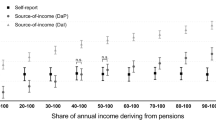Abstract
This study examines the relationship between retirement preferences, expressed as preferred retirement age, and actual retirement age in Sweden. The data were drawn from the Swedish Panel Survey of Ageing and the Elderly (PSAE). The PSAE was fielded in 2002 and 2003 with the aim of mapping living conditions of older people in Sweden. The data, which have a powerful longitudinal component, cover a broad spectrum of welfare indicators such as health, daily activities, social interactions, labour market and working conditions, and attitudes towards and experiences of retirement. Cox regression analysis was employed to explore whether and to what extent retirement preferences had any impact on actual retirement age. The results imply that retirement preferences do represent, in relation to other known key factors, an isolated influence on retirement patterns. The introduction of time-dependent variables strengthened this argument by showing how the “hazard” for the timing of retirement varied during the study period: those who preferred to retire close the end point of the study period were more likely to retire at this time than those who preferred to retire after the end of the study period and those who preferred to retire at the beginning of the study period. The results also indicated that the categories that wished to retire close to the beginning of the study period were more likely to retire at this point of time. The study thus provides empirical support for those researchers, debaters and policymakers who have addressed the importance of changing preferences towards later retirement in order to prolong working life.



Similar content being viewed by others
Notes
What is regarded as early varies between countries and branches but in this study early means to retire before the age of 65, a widely accepted social norm for retirement in Sweden (Stattin 2008).
The importance of gender differences is debated (Barnes-Farrell 2003; Dahl et al. 2002). On the one hand, women’s heavier burden in the reproductive sphere has a negative effect on their ability to work full-time and to accumulate sufficient work hours to gain full pension and this should create incentives for a longer work life. However, this effect might be mitigated for women who are part of a household with shared incomes. On the other hand, the fact that women in general are married to men who are older should prefer earlier retirement then men generally do in order to retire at the same time as their spouse (Henretta 2008).
References
Allison, P. D. (1984). Event history analysis: Regression for longitudinal data. Newbury Park: Sage Publications.
Atkinson, R. L., Atkinson, R. C., Smith, E. E., Bem, D. J., & Hilgard, E. R. (1990). Introduction to psychology. San Diego: Harcourt Brace Jovanovich.
Azjen, I., & Fishbein, M. (1977). Attitude-behavior relations: a theoretical analysis and review of empirical research. Psychological Bulletin, 84(5), 888–918.
Barnes-Farrell, J. L. (2003). Beyond health and wealth: Attitudinal and other influences on retirement decision-making. In G. A. Adams & T. A. Beehr (Eds.), Retirement: Reasons, processes, and results (pp. 159–187). Broadway: Springer Publishing Company.
Bernheim, B. D. (1987). Social security benefits: An empirical study of expectations and realizations. NBER Working Paper 2257.
Bernheim, B. D. (1989). The timing of retirement: A comparison of expectations and realizations. In D. A. Wise (Ed.), The economics of aging (pp. 335–358). Chicago: University of Chicago Press.
Bernheim, B. D. (1990). How do the elderly form expectations? An analysis of responses to new information. In D. A. Wise (Ed.), Issues in the economics of aging (pp. 259–286). Chicago: University of Chicago Press.
Bissonnette, L., & van Soest, A. (2010). Retirement expectations, preferences, and decisions panel paper 18; NETSPAR, Tilburg University.
Blane, D. (2006). The life course, the social gradient, and health. In M. Marmot & R. G. Wilkinson (Eds.), Social determinants of health (pp. 54–77). Great Britain: Oxford University Press.
Cox, D. R. (1972). Regression models and life tables. Journal of the Royal Statistical Society, 34, 187–220.
Dahl, S.-Å., Nilsen, Ø. A., & Vaage, K. (2002). Gender differences in early retirement behaviour. Working Papers in Economics 02/02, University of Bergen, Department of Economics.
Ebbinghaus, B. (2006). Reforming early retirement in Europe, Japan and the USA. Oxford: Oxford University Press.
Ekerdt, D., Vinick, B. H., & Bossé, R. (1989). Orderly endings: do men know when they will retire? Journal of Gerontology, 1, 528–535.
Erikson, R., & Goldthorpe, J. H. (1993). The constant flux: A study of class mobility in industrial societies. Oxford: Clarendon.
Esser, Ingrid (2005). Why Work? Comparative Studies on Welfare Regimes and Individuals’ Work Orientations. Doctoral thesis at the Department of Sociology. Stockholm: Stockholm University.
Feldman, D. C., & Beehr, T. A. (2011). A three-phase model of retirement decision making. American Psychologist, 66(3), 193–203. Apr 2011.
Festinger, L. (1957). A theory of cognitive dissonance. Stanford: Stanford University Press.
Gee, S., & Baillie, J. (1999). Happily ever after? An exploration of retirement expectations. Educational Gerontology, 25(2), 109–128.
Gilbert, N. (2004). Transformation of the welfare state: The silent surrender of public responsibility. USA: Oxford University Press.
Gould, R., Ilmarinen, J., Järvisalo, J., & Koskinen, S. (2008). Dimensions of Work Ability. Results of the Health 2000 Survey. Helsinki: Finnish Centre of Pensions, The Social Insurance Institution, National Public Health Institute, Finnish Institute of Occupational Health.
Gustman, A. L., & Steinmeier, T. L. (1984). Partial retirement and the analysis of retirement behavior. Industrial & Labor Relations Review, 37, 403–415.
Halleröd, B., Örestig, J., & Stattin, M. (2012). Way out of control? The impact of exit-routes from employment to retirement on wellbeing in old age. Working paper.
Hanson, K., & Wapner, S. (1994). Transition to retirement: gender differences. International Journal of Aging & Human Development, 39(3), 189–208.
Henkens, K. (1999). Retirement intentions and spousal support: a multi-actor approach. Journal of Gerontology, 54B, 63–74.
Henkens, K., & Tazelaar, F. (1997). Explaining retirement decisions of civil servants in the netherlands intentions, behavior; and the discrepancy between the two. Research on Aging, 2, 139–173.
Henretta, J. C. (2008). Recent trends in retirement. Reviews in Clinical Gerontology, 4, 71–81.
Hult, C., & Svallfors, S. (2002). Production regimes and work orientations: a comparison of six western countries. European Sociological Review, 18(3), 315–331.
Jensen, P. H., Andersen, C., & Breidahl, K. N. (2006). Arbeide eller efterløn? En erfaringsopsamling [Employment or retirement? A summary of empirical findings]. Copenhagen: Frydelund.
Kangas, O., Lundberg, U., & Ploug, N. (2010). Three routes to pension reform: politics and institutions in reforming pensions in Denmark, Finland and Sweden. Social Policy and Administration, 44, 265–284.
Karasek, R. T., & Theorell, T. (1990). Healthy work: Stress, productivity and the reconstruction of working life. US: Basic books.
Keese, M. (2006). Live longer, work longer. OECD.
Krueger, A. B., & Meyer, B. D. (2002). Labor supply effects of social insurance. In A. J. Auerbach & F. Feldstein (Eds.), Handbook of public economics Volume 4 (pp. 2327–2392). Amsterdam: Elsevier.
Lukes, S. (2005). Power. A radical view. New York: Palgrave.
Manski, C. F. (2004). Measuring expectations. Econometrica, 5, 1329–1376.
Manski, C. F., & Tamer, E. (2002). Inference on regressions with interval data on a regressor or outcome. Econometrica, 2, 519–546.
Mathieu, J. E., & Zajac, D. M. (1990). A review and meta-analysis of the antecedents, correlates, and consequences of organizational commitment. Psychological Bulletin, 108, 171–194.
Nussbaum, M. C. (2001). Women and human development: The capabilities approach. Cambridge: Cambridge University Press.
Örestig, J. (2012). Age and Extrinsic/Intrinsic Work Values in Sweden, 1979–2003, Working paper.
Phillipson, C. (2007). Is extending working life possible? Resarch and policy issues. In W. Loretto, S. Vickerstaff, & P. White (Eds.), The future of older workers. New perspectives (pp. 185–204). Bodmin: Polity Press.
Raymo, J. M., Warren, J. R., Sweeney, M. M., Hauser, R. M., & Ho, J. H. (2010). Later-life employment preferences and outcomes: the role of midlife work experiences. Research on Aging, 32, 419.
Reday-Mulvey, G. (2005). Working beyond 60: Key policies and practices in Europe. New York: Palgrave Macmillan.
Siegrist, J., Wahrendorf, M., von dem Knesebeck, O., Jürges, H., & Börsch-Supan, A. (2007). Quality of work, well-being, and intended early retirement of older employees: baseline results from the SHARE study. European Journal of Public Health, 17(1), 62–68.
Singer, J. D., & Willett, J. B. (2003). Applied longitudinal data analysis: Modeling change and event occurrence. USA: Oxford University Press.
SOU (2002). Riv ålderstrappan! Livslopp i förändring [Dissolve the Stairway of Age. Lifecourse in Change]. Swedish Government Official Report 2002:29, The Swedish Ministry of Health and Social Affairs: Stockholm.
SOU (2011). Långtidsutredningen: huvudbetänkande, [The Long Term Report] Swedish Government Official Report The Swedish Ministry of Finance, Stockholm: Offentliga förlaget.
Stattin, M. (1998). Yrke, yrkesförändring och utslagning från arbetsnarknaden. En studie av relationen mellan förtidspension och arbetsmarknadsförändring. Doctoral thesis at Umeå University: Umeå.
Stattin, M. (2008). Pension preferences and work environment. In M. Kumashiro (Ed.), The Promotion of Work Ability Towards Productive Aging: Selected Papers of the 3rd International Symposium on Work Ability, Hanoi, Vietnam, 22–24 October 2007 (pp. 143–154). Wiltshire: CRC Press.
Sunstein, C. R. (1997). Free markets and social justice. USA: Oxford University Press.
Szinovacz, M. (1986). Preferred retirement timing and retirement satisfaction in women. International Journal of Aging & Human Development, 24, 301–317.
van den Berg, T. I. J., Elders, L. A. M., & Burdorf, A. (2010). Influence of health and work on early retirement. Journal of Occupational and Environmental Medicine, 52, 576.
van Solinge, H., & Henkens, K. (2008). Adjustment to and satisfaction with retirement: two of a kind? Psychology and Aging, 23, 422–434.
van Solinge, H., & Henkens, K. (2010). Living longer, working longer? The impact of subjective life expectancy on retirement intentions and behaviour. European Journal of Public Health, 20(1), 47–51.
Vogel, J., & Häll, L. (2006). Living conditions of the elderly. Work, Economy, Health and Social Networks 1980–2003. Sweden: Statistics Sweden, Report no 112.
Wang, M., & Shultz, K. S. (2010). Employee retirement: a review and recommendations for future investigation. Journal of Management, 36, 172–206.
Wang, M., Henkens, K., & van Solinge, H. (2011). Retirement adjustment: a review of theoretical and empirical advancements. American Psychologist, 66(3), 204–213. Apr 2011.
Weinberger, M. B. (2007). Population aging: A global overview. In M. Robinson (Ed.), Global health and global aging (pp. 15–30). San Francisco: Jossey-Bass.
Zappala, S., Depolo, M., Fraccaroli, F., Guglielmi, D., & Sarchielli, G. (2008). Postponing job retirement? Career Development International, 13, 150–167.
Author information
Authors and Affiliations
Corresponding author
Rights and permissions
About this article
Cite this article
Örestig, J., Strandh, M. & Stattin, M. A Wish Come True? A Longitudinal Analysis of the Relationship between Retirement Preferences and the Timing of Retirement. Population Ageing 6, 99–118 (2013). https://doi.org/10.1007/s12062-012-9075-7
Received:
Accepted:
Published:
Issue Date:
DOI: https://doi.org/10.1007/s12062-012-9075-7




